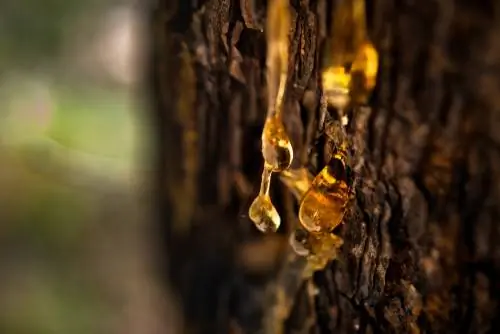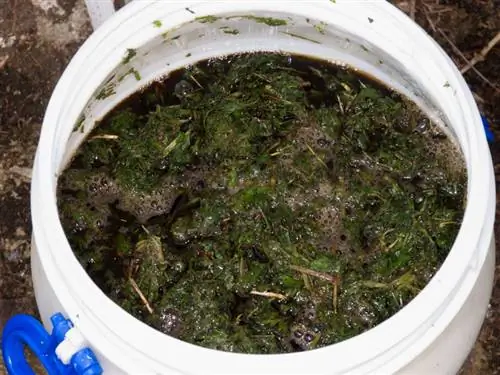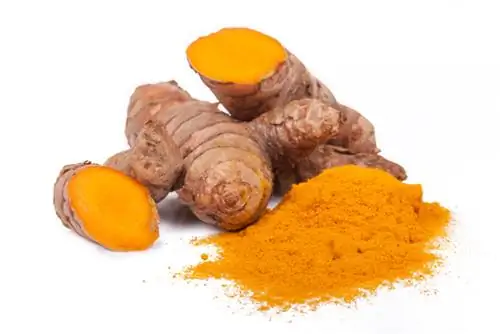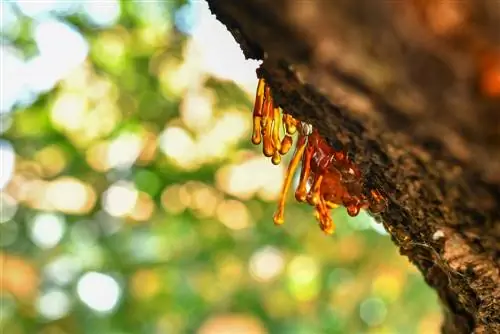- Author admin [email protected].
- Public 2023-12-16 16:46.
- Last modified 2025-01-23 11:22.
Tree resin is the liquid gold of the forest. But the golden natural product is causing trouble for drivers and pet owners. The properties of resin make it a feared yet popular substance. Its possible applications are extremely versatile.

What is tree sap and how do you remove it?
Tree resin is a metabolic product of trees that is used to close wounds and protect against infections. It can be removed from clothing, hair and surfaces with oily agents such as butter, cooking oil or cream. Resin has a wide range of uses, e.g. in ointments, incense or as natural chewing gum.
What is tree resin?
Resin is a metabolic product of various trees, which consists of the ingredients rosin and turpentine. If the bark of a tree is injured, it increases the production of the natural substance. The viscous and sticky mass emerges from the resin channels that run through the entire tree. They close the wound by allowing it to air dry and harden. The essential oils evaporate. The smell, consistency and color of tree resin differ depending on the tree species.
- tropical tree resin: elemi, copal
- East Indian tree resin: Dammar
- fossil tree resin: amber
Excursus
Fossil and recent resin
The resin that trees still excrete today is called recent resin. On the other hand, fossil resin is known as amber. Amber believed to be more than 99 million years old has been found in a mine in Myanmar. It contains around 40 different species of land and sea creatures.
Mites, millipedes, flies and spiders were preserved for eternity, but the researchers found a sensation. In addition to four shells from smaller sea snails, the tree resin contained an ammonite. This amber is the only specimen containing a fossil cephalopod from the sea.

Resin traps insects for eternity
Remove resin
It is annoying when there is resin in clothing, in the fur of dogs and cats or on wood. The sticky mass is usually difficult to remove from jeans, tents or skin. There are various options for removing unsightly residue from tiles or the saw blade. Various tree resin removers (€9.00 on Amazon) such as Sonax are available in stores, but the sticky mass can usually be removed easily using home remedies.
| Medium | Application | |
|---|---|---|
| from hair | Butter | rub and rinse |
| from car paint | alcoholic door lock de-icer | dab carefully |
| from clothes | Cooking oil | rub in and then wash |
| by hands | nourishing baby oil | rub gently and rinse off |
| made of dog fur | Ballistol | spray on and wipe with a cloth |
| from the parquet | Nivea cream | wipe carefully with a cloth |
| from plastic | Cola, lemon acid | Soak and wipe stain |
Properties of resin
Natural resin is not water-soluble and therefore cannot be removed with pure water. It solidifies at normal temperatures and becomes liquid again when warm. Tree resin dissolves in both fat and alcohol.
If you want to remove stains from textiles with oil, you must then wash out the grease stains. Grease is easier to remove at high temperatures above 60 degrees, so only suitable items of clothing should be cleaned this way. You can also remove resin stains from the car's paint or car window with warm water.
These products are suitable for removing stains
- Liquefying: warm water or hot air dryer
- Thinning: Universal thinner, acetone-free nail polish remover, shaving foam
- Solving: Cooking oil, penetrating oil, Ballistol, spirit
What to do if resin has burned into the car paint?
Many drivers have a negative impression of tree resin because the sticky substance is difficult to remove from the car or window. The natural product is not harmful to the paint. The longer the resin stays on the paint, the more the natural substance hardens and makes cleaning all the more difficult.
Burned-in resin can be removed with a white spirit substitute. Dampen a microfiber cloth with the liquid and pat the area. Allow the agent to absorb a little and then work on the resin stain with the soft cloth. The resin is gradually removed. This method leaves no residue and is gentle on the paint.

What can you do with tree resin?
The natural product is used for a variety of purposes. Rosin is the most famous resin product, obtained from the sap of spruce and pine trees. It is used to treat the bow hair that is stretched on violin bows. Rosin is also used as an adhesive for adhesive plasters. In the 15th century, resin was used as a binding agent for color pigments. Such oil-resin paints are still popular today and are preferred for painting. In Greece, the resin of the Aleppo pine is used as a flavoring additive to a wine that became known as Retsina.
Tree resin is a well-known substance that is not only used as glue.
Buy tree resin
Tree resin is available as a solid product or a liquid product. When purchasing, pay attention to organic quality, because as a natural product, pure tree resin is free of additives. To obtain liquid tree resin, you can gently heat the resin pieces. The essential oil of the resin is extracted by steam distillation.
Tip
You don't necessarily have to buy resin. Go into the forest and look for resin beads on conifers. These can be easily processed further.
chewing gum
People have been chewing on tree resin since the Stone Age. It was popular with both the ancient Egyptians and Native Americans. The Maya chewed dried resin from the pulp apple tree, also known as the gum tree. Many forest workers know spruce resin as chewing pitch, which has a long tradition among lumberjacks.
If you want to try out the natural chewing gum on a walk in the forest, you should look out for fresh spruce resin. Press it with your finger. It should be neither too firm nor too soft. It is ideal if the resin shimmers reddish-golden. Allow a small chunk to soften in your mouth before chewing. After a while it will feel like regular chewing gum.
Natural chewing gum from all over the world:
- Siberian cedar gum
- Swedish Tugg-Kåda made of spruce resin
- Alpine gum made from pine resin, birch sugar and beeswax
Make your own ointment
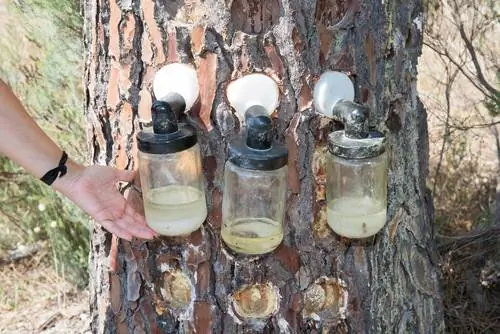
Tree resin is also often used for ointments
The resin ointment has numerous positive properties. It has antibacterial and antiviral effects and is used to disinfect wounds. The so-called pitch ointment promotes blood circulation, relieves pain and warms cold feet. It is used against muscle tension and to pull out splinters.
If you want to collect resin yourself, you should only harvest as much as necessary. In order not to stress the tree unnecessarily, only the resin beads are collected. A wooden scraper makes collecting easier and prevents the resin from sticking to your hands. Always leave some resin behind so that the wound stays closed in the bark and does not start bleeding again.
For further processing, you should use a fireproof container that can get dirty. Resin residues often remain. To clean the resin, put the chunks in a tea strainer or cotton bag. You can melt the resin by heating it. It liquefies and flows through the sieve while residue is filtered out.
Recipe:
- Slowly heat 30 grams of resin with 100 milliliters of olive oil and two tablespoons of marigold flowers
- Let it steep for 60 minutes and remove the filter
- Strain oil through a sieve
- Heat the liquid again and melt 13 grams of beeswax in it
- Let cool while stirring
- canning
Smoking
Pure tree resin can be smoked effectively on charcoal. The coal is lit and placed on a fireproof dish. The resin fills the room with its ethereal scents. Once the resin has completely hardened, you can grind it finely and smoke it in a smoking sieve. This is previously covered with a layer of sand.
Tip
You can also use aluminum foil and a warmer. Place the aluminum foil on the warmer and place a tea light underneath.
Frequently asked questions
How long does homemade resin ointment last?
Resin has preservative ingredients. Its antibacterial properties also ensure that the ointment does not spoil. A homemade cream has a shelf life of at least twelve months and can be kept refrigerated for even longer.
What are the areas of application of propolis tree resin ointment?
The cream is a mild care for heavily stressed or sensitive skin. The nourishing ingredients protect dry skin from excessive water loss. Rough, cracked and brittle or flaky skin becomes softer and more elastic thanks to the fatty film. Due to its antibacterial and disinfectant properties, the ointment can also be used to close wounds. It is painless and promotes wound healing.
Is resin edible?
Tree resin has been used as natural chewing gum for thousands of years. It is used for dental care because it disinfects, keeps teeth white and promotes he althy and strong gums. However, you shouldn't eat it. The taste of different tree resins is perceived very differently. If you want to try tree resin yourself, you should take a look at the smell and find out whether it is pleasant for you. The reddish-gold shimmering resin is suitable as chewing gum and is neither too liquid nor completely hardened.
Can you make jewelry out of tree resin?
Tree resin liquefies when heated and can then be poured into molds or shaped with your hands. However, after cooling, it retains its sticky properties and body heat makes it soft again. Synthetic resin is more suitable for making jewelry. The casting resin, which can be poured into silicone molds, is popular.
Is tree sap toxic to cats?
Resin is rich in essential oils, which are irritating in high doses. Therefore, tree sap is sometimes classified as toxic to cats. Therefore, do not let your four-legged friend scratch and gnaw on the Christmas tree. If resin sticks to your pets' fur, you can simply wash out the residue with oil.

